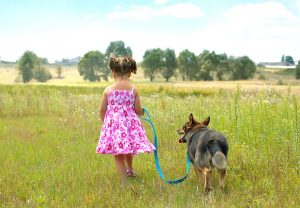Get Your Gear for Great Walks
May 15, 2017

Dog walks are not always as peaceful as the sweet image above! Training collars and harnesses are just that — training equipment not forever equipment — but they can give us a break from intense pulling and lunging. Training equipment can also give us some behavioral traction with dogs who are intensely excited about meeting other dogs and people — as well as confidence when handling dogs who behave in a frustrated or aggressive manner.
The Sensations Harness is my tool of choice. You can view the Sensations Harness and look at the company’s fit and size guide here. Why do I like it? Easy to fit, easy to use, and little to no acclimation time for the dog. There are lots of similar, front-attached harnesses out there but this one has my vote! One caveat… if you’re running with your dog, allowing him to romp off-leash, or exercising him energetically in any other way — leave his front clip harness off during that time.
The Thunderleash is a newer player on the scene and — you guessed it — was developed by the company who produce the Thundershirt. The Thunderleash uses pressure on the dog’s chest to discourage pulling. It has a very simple design and is also easy to use — converting quickly back and forth between a regular leash and a no-pull leash.
Body Harnesses can be terrific for dogs who are escape artists and easily back out of their collars, but they aren’t the best for dogs who pull on leash. Think about the Iditarod… dogs wear body harnesses with leads attached to their backs. This gives them the greatest capacity to pull the sled forward! One thing we don’t want to do is give our dogs more capacity to pull us… So if your dog pulls on leash, go with the Sensations Harness or perhaps the Freedom Harness for back and chest points of attachment.
Another important benefit of harnesses… the physical well-being of our dogs. When we discuss pulling and lunging, we generally focus on our frustration but not necessarily on the potential for injury. This article sums it up well: neck injuries (bruising, headaches, whiplash, and injuries to trachea and larynx), eye issues (pressure from pulling can worsen corneal issues, glaucoma, and other eye injuries), and thyroid gland (inflammation). Pain from collars or inappropriate equipment also how the potential to increase behavioral issues.
Head Collars or Halters include Gentle Leaders, Comfort Trainers, Halti Head Halters, and Snoot Loops. Not all dogs are candidates for head halters, but they can sometimes be valuable when working through behavioral issues such as aggression and reactivity — and for dogs who like to launch love attacks at other pedestrians and pups! There is some potential of injury to the neck if a dog hits the end of a leash hard, or if he is given harsh corrections. Here’s one trainer’s view on using them “Are Dog Head Collars Humane? I Changed My Mind.”
Martingale Collars are not great tools for preventing pulling, but like regular body harnesses, can prevent flight risk dogs from slipping their collars and completing a few victory laps! Dogs can slip their collars not only because they really do want to run free, but also because they startle easily and try to get away. If you have a dog who is environmentally sensitive (scared by cars, bikers, joggers) or is nervous getting out of the car at new places — a martingale collar could be a good choice. Also called greyhound or limited-slip collars, martingale collars are great for dogs with narrow heads (like greyhounds!).
Flat Collars simply provide a place to attach id tags and a leash. Need to acclimate your puppy to a collar and leash? Start with a basic flat collar or simple harness and when he’s completely comfortable wearing it, also teach your puppy that collar grabs are a great thing! Last, flat collars are the perfect piece of equipment for a dog who understands loose leash walking and/or formal heeling — no restraint or extra control required!
What is your preferred equipment when out for a walk with your dog? Let me know what makes your walks more peaceful!
Written by Susan Marett








